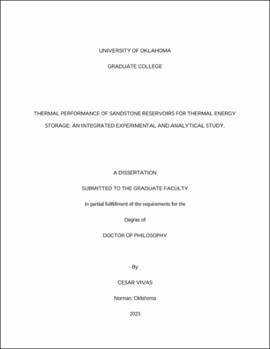| dc.description.abstract | With the global plans of decarbonization in motion, major energy players and large oil and gas (O&G) companies are moving towards increasing energy generation from non-fossil sources. The implementation of renewable energy has a critical constraint, the intermittent nature of the renewables. Energy storage systems help overcome the seasonal intermittence of renewable power generation sources. Besides, thermal energy storage (TES) systems can optimize renewable energy management, providing equilibrium between energy generation and demand. For utility-scale projects, the TES systems must be capable of storing an extensive amount of heat.
The thermal capability of subsurface rocks to store heat makes them an optimal option for energy storage. A subsurface thermal energy storage can store the energy surplus generated by solar and wind plants. The energy excess is used to heat a heat transfer fluid; then, this fluid is injected into the geothermal sedimentary reservoir. When solar or wind cannot generate energy or the demand is higher than production, the energy stored in the thermal battery is extracted for thermal direct use or power generation. Subsurface TES can store a considerable quantity of energy at a reasonable cost. Sedimentary formations in oil and gas basins offer multiple advantages for being TES solutions. O&G basin sands are i) deep enough to store water at high pressure, ii) usually offer higher porosity (storage capacity) and higher permeability (flow capacity) than volcanic rocks or shales, iii) the water stored is confined by sealing rocks, and iv) the sedimentary reservoirs frequently offer large volumes to store the hot water.
This dissertation aims to evaluate the thermal performance of sandstone reservoirs for thermal energy storage applications. The research encompasses a comprehensive experimental analysis of 30 sandstone samples, encompassing petrophysical and thermal rock properties, rock mineralogy, and rock texture analyses. The specific objectives are: i) establish connections between the porosity, permeability and density of sandstone rocks and their thermal behavior, with a focus on thermal energy storage applications, ii) Establish correlations between the mineralogy and other rock properties, such as thermal properties and textural features, to comprehend the influence of mineral composition on the sandstone's behavior and performance iii) understand the relationships between textural properties and thermal properties, and iv) evaluate the impact of the natural heterogeneity of sandstone properties in the thermal energy storage reservoir performance. | en_US |
